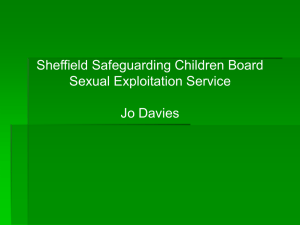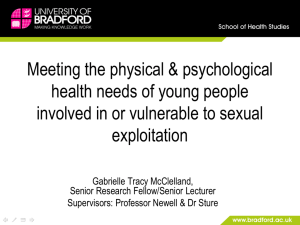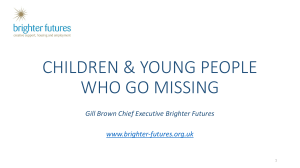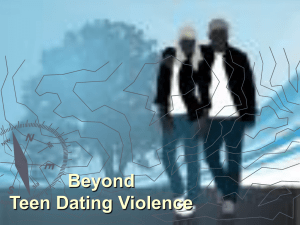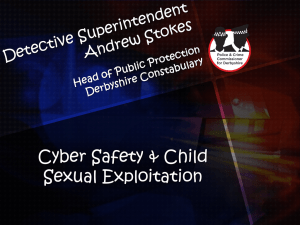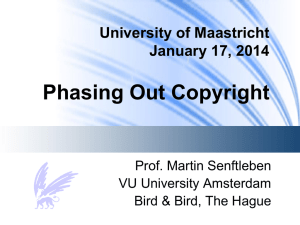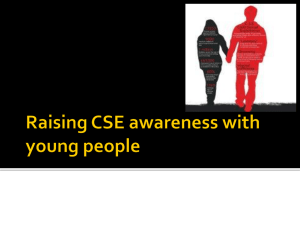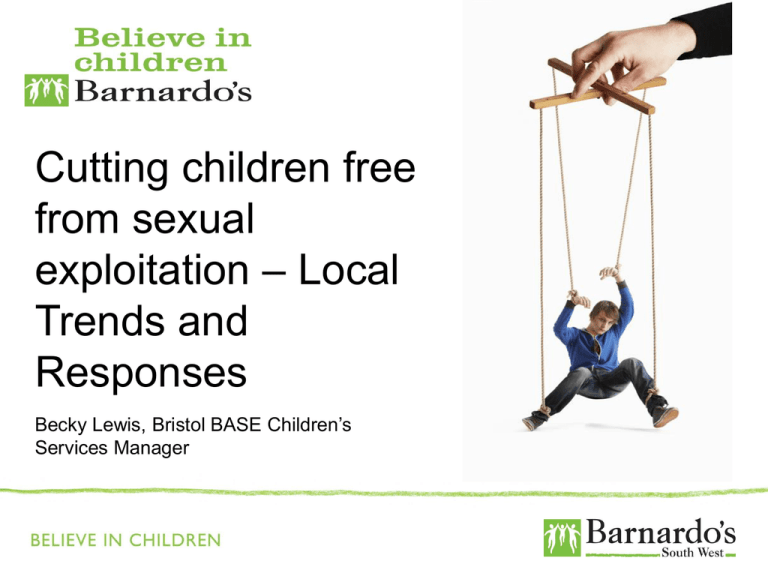
Cutting children free
from sexual
exploitation – Local
Trends and
Responses
Becky Lewis, Bristol BASE Children’s
Services Manager
Our work on child sexual exploitation
•
Began addressing child sexual exploitation in 1994
•
•
Opened first service and challenged ‘child prostitution’
Four dimensions to Barnardo’s work on sexual exploitation
•
Direct work: 1:1 & group, health, missing return visits, parenting
work
•
Training and Consultation: Awareness-raising / training for
professionals
•
Research: Assess trends, risk factors and consequences
•
Policy: Influence UK, devolved and local government
Our specialist support services
•
Working in 40 local authorities nationally
•
Worked with over 2,000 sexually exploited young people
in 2013-2014 and annually work with over 6,000 young
people delivering preventative work
•
•
•
•
Increasing proportion are male (19% Bristol Apr-Sept
2014)
Approx 1/4 are from BME communities (37.9% Bristol AprSept 2014)
Average age is reducing; significant proportion ~13 years
4 A’s: Access, Attention, Assertive outreach, Advocacy
Bristol BASE
•
•
•
•
•
•
•
(Barnardo’s Against Sexual Exploitation)
Opened in 1997
Working with both young men and women up to the age of 18 –
providing a flexible, non-time limited service to some of the most
vulnerable young people in the city
Multi-disciplinary team
Working with the hardest to reach and most socially excluded young
people
Joint working with key partner agencies (CYPS, Police, Education &
Health)
Hub & Spoke Model: Currently have SLA with South
Gloucestershire and Spot Purchasing arrangements with BANES,
North Somerset, Somerset, Swindon, Wiltshire, Avon and Somerset
Constabulary and private residential units in the area
Worked with 115 young people in the last 6 months
Models of Exploitation
Peer
Exploitation
Gang
Involvement &
Drug Running
Party Model
Hotels/Flats
Formal
Street/Parlour
Based
Exploitation
Trafficked
Young People
Self Generated
Indecent
Imagery
Boyfriend
Model
Online
Exploitation
•Lone abusers but
increasingly
networked
•Female abusers
•Children
exploited as
recruiters
•Family members
implicated
Perpetrator Activity
Perpetrator Activity
The bigger picture locally
•
•
•
•
•
•
•
•
•
•
Hidden scene – little street/parlour work
Exploitation happens in houses and flats
Less formal selling of sex but sex in exchange for accommodation,
drugs, alcohol, clothes, friendship
Geographical ‘hotspots’
Peer, controlling boyfriends – gateway to much older abusers
Older females grooming young people
Running away from home/care
Underground issue - new technologies
Internal trafficking
Drug running and gang involvement
What works?
“Well do you think I just woke up one day and thought ‘ I
know I’ll be a rent boy today?’
Thousands of things have happened to get me here – mum
leaving, no one at home, hanging around the pub late
and waiting to go home with dad. Having blokes try and
touch us up, seeing boys do tricks and getting cash and
fags.
If you want to change me, you’re probably going to have to
do thousands of things just to balance it out”
(BASE Young Person – aged 15)
Barnardo’s Evidence Based
4 A’s Model
Access
Friendly, welcoming and safe service
Easy referral process
Short waiting lists, if any
Practical support facilities
‘One stop’ multi-disciplinary team
Open and honest intervention – ‘no secrets’
policy
Respectful of young peoples choices and
rights
Support on young persons terms, at their
pace
Non-time limited intervention
Assertive Outreach
Core belief that no child is ‘un-engagable’
Establishing and maintaining contact – not
giving up
Flexible, responsive approach
Tracking children down
Making engagement easier for young people
Attention
Consistent and persistent attention from a
trusted adult
Safe and secure relationship formed with their
key worker but also a team response when in
crisis
Therapeutic response that demonstrates
genuine care and concern and begins to
counteract the attention from abusers
Strengths based model of working, not deficit
model
Recognition of positive change through rewards
Holistic attention about the child’s life
Advocacy
Mediation work
Educating and influencing external professionals
Conveying the child’s voice and wishes
Ensuring their needs are not overlooked
Advocacy for effective care plans
Engagement &
Assessment Period
Therapeutic Support
Period
Moving on Period
Harm reduction & Safety
planning work
Structured CSE support
sessions
- Grooming
- Consent
- Internet safety
- Abusive relationships
Exiting exploitative
relationship work
Practical support
Trauma recovery work
Court support
Crisis Intervention Support
Emotional containment/regulation support
Family Work & Placement Stability Support
Court Work – Family & Criminal Court
Access to BASE sexual health nurses and CAMHS nurse when/if required
Intensive Multi-agency working
Perpetrator identification, mapping, and implementation of multi-agency disruption
plans
What are the challenges?
•
Making contact with disengaged children and young people
•
Child Protection arrangements – focus is often on the child’s ‘difficult’
behaviour rather than the abuse they’ve encountered and continue to
experience
•
Building trust takes a significant amount of time due to being repeatedly let
down
•
Children and young people are the agents of their own risk
•
Response is victim led rather than focused on disrupting perpetrator
networks resulting in low prosecution rates of perpetrators
•
The needs of these young people are still not on the agenda compared with
the needs of much younger children despite learning from serious case
reviews
Principles for Young Person
Centred Practice
Specialist support
that isn’t
disclosure
dependant or
prescriptive
Changes to the
judicial system. In
the meantime use
of special
measures
Knowledgeable
professionals
whose actions and
interventions
challenge blame
Plans that preempt periods of
disruption –
expectations aren’t
unrealistic
Robust perpetrator
responses –
location &
individual
strategies
Break away from
blinkered
individual child
focus recognising
victim networks
Continuity of
support – workers,
carers and police
officers that don’t
change
Prevention and
early
intervention
Persistent,
consistent and
assertive
support
BASE DVD
Government Guidance and
Learning from SCRs
Coffey, A (2014) Real Voices: Child sexual exploitation in Greater
Manchester, An independent report by Ann Coffey, MP
DCSF Guidance (2009) Safeguarding Children and Young People from
Sexual Exploitation
DFE (Nov 2013) Tackling Child Sexual Exploitation Action Plan and Action
Plan – Progress Report
DFE (Jan 2014) Statutory guidance on children who run away or go missing
from home or care
DH Child sexual exploitation: health working group report (Jan 2014)
Derby Safeguarding Childrens Board (Aug 2013) Operation Kern Learning
Review Summary
Independent Inquiry into Child Sexual Exploitation in Rotherham (1997 –
2013) The Jay Report 2014
Oxford County Council (Nov 2013) Action in Response to Child Sexual
Exploitation in Oxfordshire
Rochdale Borough Safeguarding Childrens Board (Dec 2013) The Overview
Report of the Serious Case Review (redacted)
Torbay Safeguarding Childrens Board (Feb 2013) Serious Case Rebview
Executive Summary Case 26
Current literature and research
• Barnardo’s (2011) Puppet on a string: The urgent need to cut children free from child
sexual exploitation. London: Barnardo’s
• Barnardo’s (2013) Running away from hate to what you think is love. London:
Barnardo’s
• Barnardo's(2014) Report of the Parliamentary inquiry into the effectiveness of legislation
for tackling child sexual exploitation and trafficking within the UK – Chaired by Sarah
Champion MP
• Beckett, H ., Brodie, I., Factor, F., Melrose, M., Pearce, J; Pitts, J; Shuker, L &
Warrington, C. (2013) ‘It's wrong…but you get used to it' A qualitative study of gangassociated sexual violence towards, and exploitation of, young people in England.
University of Bedfordshire: Bedfordshire
• Berelowitz, S., Clifton, J., Firimin, C., Gulyurtlu, S. & Edwards, G. (2013) “If only
someone had listened”: Office of the Children’s Commissioner’s Inquiry into Child Sexual
Exploitation in Gangs and Groups. Final Report. The Office of the Children’s
Commissioner: London
• CEOP (2011) CEOP Thematic assessment: Out of Mind, Out of Sight: Breaking down
the barriers to understanding child sexual exploitation. London: CEOP
• Coy, M., Kelly, L., Elvines, F., Garner, M., &Kanyeredzi , A. (2013) “Sex without consent,
I suppose that is rape”: How young people in England understand sexual consent. Office
of the Children’s Commissioner: London
• Department of Health (DoH) (2014) Child sexual exploitation: health working group
report The Stationary Office: London
www.barnardos.org.uk/cse

